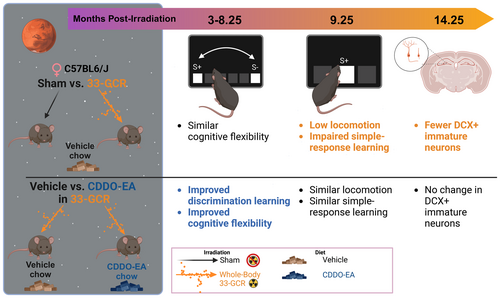Space exploration faces many challenges, but one often overlooked threat is galactic cosmic radiation (GCR). A recent study published in the Journal of Neurochemistry has uncovered concerning evidence about GCR’s long-term effects on female cognition, potentially impacting future space missions.
Summary: A new study shows galactic cosmic radiation can cause lasting learning deficits in female mice, with implications for long-term space missions. An antioxidant compound may help mitigate these effects.
Estimated reading time: 5 minutes
The Hidden Dangers of Space Radiation
Current spacecraft shielding cannot fully protect astronauts from GCR, a form of radiation permeating outer space. While previous research demonstrated short-term cognitive deficits in male rodents exposed to GCR, this new study reveals that female rodents may suffer long-lasting learning impairments.
The research team, led by Dr. Sanghee Yun from the Children’s Hospital of Philadelphia Research Institute and the University of Pennsylvania Perelman School of Medicine, conducted a comprehensive study on female mice to understand the long-term cognitive effects of GCR exposure.
Study Design and Key Findings
The researchers used mature female C57BL/6J mice, exposing them to whole-body 33-beam GCR (33-GCR) at a dose of 0.75 Gy. They then assessed the mice’s cognitive abilities three months post-irradiation using touchscreen-based tests and arena-based behavior tests.
Key findings include:
- GCR-exposed mice showed slower stimulus-response learning compared to control groups.
- GCR exposure resulted in fewer doublecortin-immunoreactive (DCX+) dentate gyrus immature neurons, indicating potential impacts on neurogenesis.
- The antioxidant and anti-inflammatory compound CDDO-EA appeared to mitigate some of the cognitive deficits caused by GCR exposure.
Implications for Space Exploration
This study has significant implications for long-term space missions, particularly those involving female crew members. Dr. Yun stated, “Our study lays the groundwork for future causal delineation of how the brain responds to complex GCR exposure and how these brain adaptations result in altered behaviors.”
The research suggests that space agencies may need to reconsider radiation protection strategies and potential cognitive support for astronauts on extended missions, such as those planned for Mars exploration.
Potential Countermeasures
One promising aspect of the study was the positive effect of CDDO-EA, an antioxidant and anti-inflammatory compound. Mice fed with CDDO-EA before and after radiation exposure showed improved cognitive performance compared to those without the compound.
This finding opens up possibilities for developing dietary supplements or other interventions to protect astronauts’ cognitive health during long-term space missions.
Beyond Space: Broader Implications
While the study focuses on space radiation, its findings contribute to a broader understanding of radiation’s long-term impact on cognitive health. This research could have implications for radiation therapy patients, nuclear workers, and others exposed to high levels of radiation on Earth.
The study’s innovative use of touchscreen-based cognitive tests on mice also provides a new model for assessing complex cognitive functions in animal studies, potentially benefiting various fields of neuroscience research.
Questions and Future Research
Several questions remain:
- How do these findings translate to human cognition?
- Are there sex-based differences in radiation sensitivity that need to be considered in space mission planning?
- Can CDDO-EA or similar compounds be safely used as long-term dietary supplements for astronauts?
Future research will need to address these questions and explore additional countermeasures to protect astronauts’ cognitive health during deep space missions.
As we push the boundaries of space exploration, understanding and mitigating the risks of cosmic radiation will be crucial for the success and safety of future missions. This study marks an important step in that direction, particularly in considering the health of female astronauts.
Quiz
- What type of radiation did the study focus on?
- How long after radiation exposure were the mice’s cognitive abilities assessed?
- What compound showed potential in mitigating cognitive deficits caused by radiation exposure?
Answer Key:
- Galactic cosmic radiation (GCR)
- Three months
- CDDO-EA
Further Reading:
- NASA’s Space Radiation Program: https://www.nasa.gov/hrp/elements/radiation
- Effects of Space Radiation on the Central Nervous System: https://www.ncbi.nlm.nih.gov/pmc/articles/PMC10044754
- Why Do We Need to Use Animal Models to Study Cognition and Aging?: https://www.nature.com/articles/npp201045
Glossary of Terms:
- Galactic Cosmic Radiation (GCR): High-energy particles originating from outside our solar system.
- Neurogenesis: The process by which new neurons are formed in the brain.
- Doublecortin (DCX): A protein expressed in immature neurons, used as a marker for neurogenesis.
- Dentate Gyrus: A region of the hippocampus involved in memory formation and spatial navigation.
- CDDO-EA: An antioxidant and anti-inflammatory compound used in the study.
Enjoy this story? Get our newsletter! https://scienceblog.substack.com/
If our reporting has informed or inspired you, please consider making a donation. Every contribution, no matter the size, empowers us to continue delivering accurate, engaging, and trustworthy science and medical news. Independent journalism requires time, effort, and resources—your support ensures we can keep uncovering the stories that matter most to you.
Join us in making knowledge accessible and impactful. Thank you for standing with us!

